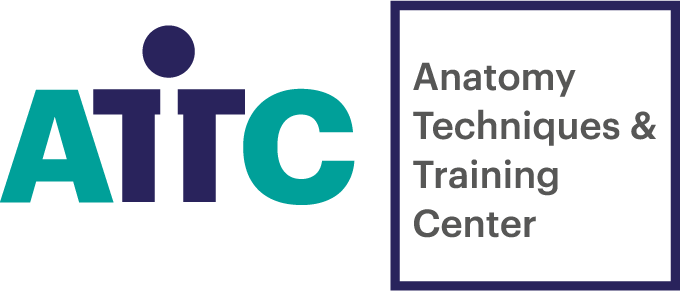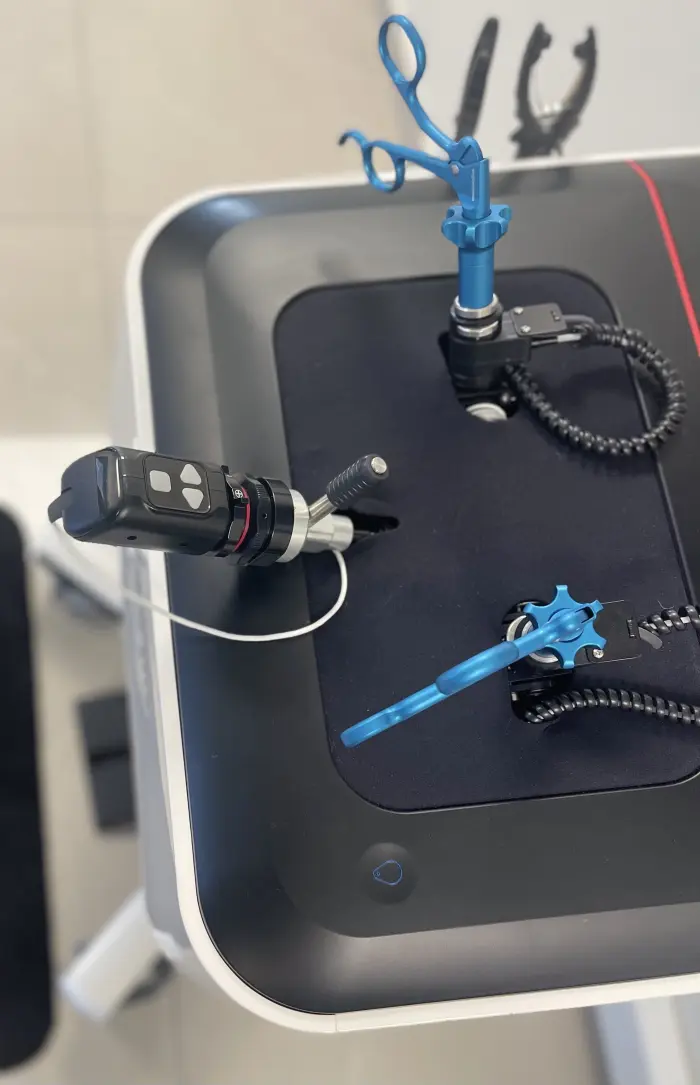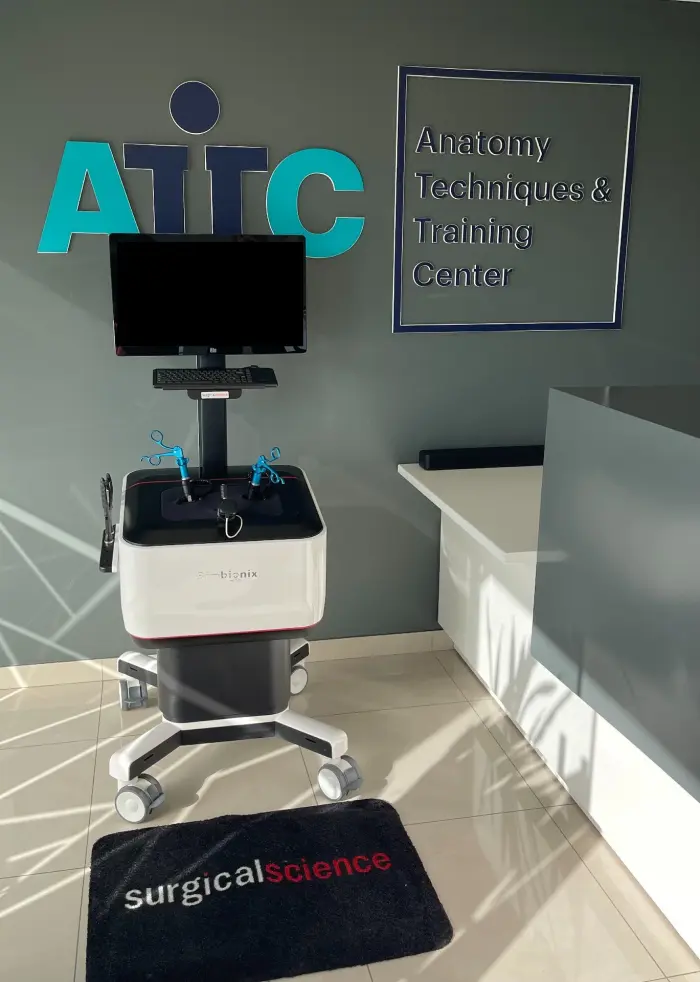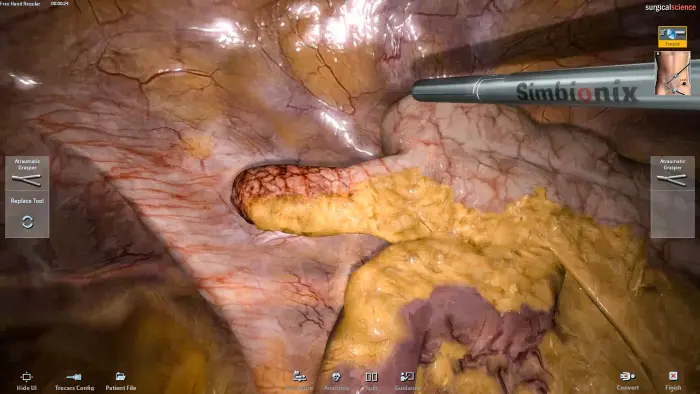Training Program of Virtual Reality Simulation in Minimally Invasive Surgery
The Simulator
Training is based on the use of the LAP Mentor III platform (Surgical Science – Simbionix). This is a state-of-the-art simulator, with numerous studies supporting its validity and usefulness. The advantages of the platform include:
- High fidelity and definition graphics
- Multiple parameters that are calculated and reported at the end of each task
- Option of use of needleholder handle for respective tasks
- Height adjustment for improved ergonomics
- Novel camera accurately replicating actual laparoscopic camera (focus, field size, viewing angle)
- High accuracy haptic feedback
- Latest software version
Training curricula
The training curricula implemented at ATTC for simulation in minimally invasive surgery, follow the principle of “low intensity – high frequency” training. The program offers the following curricula:
- Basic Laparoscopic Skills (BLS)
This curriculum is addressed to trainees with limited previous experience in laparoscopic surgery and comprises the basis for more advanced curricula in general surgery, gynecology, urology, thoracic surgery and other surgical specialties. The objective of the curriculum is the acquisition of basic skills such as depth perception in a bi-dimensional environment, hand-hand coordination, understanding fulcrum effect and familiarization with laparoscopic instruments. - Basic Laparoscopic Suturing (BLSu)
This curriculum is addressed to trainees who are familiar with the principles of laparoscopic surgery and desire to acquire the significantly complex, demanding and enabling skill of laparoscopic suturing, that is useful for all surgical specialties. The objective of this curriculum is the understanding of basic geometry of the complex “tissue-needle-needleholder”, of the appropriate mounting of the needle onto the needleholder, of the smooth movement in three axis for effective positioning of the suture, as well as all the recommended ways for intracorporeal knot-tying. - Essential Gynecological Tasks (EGT)
This curriculum is addressed to trainees with previous experience in laparoscopic surgery who wish to train in gynecological surgery. The curriculum includes surgical procedures such as fallopian tube ligation, surgical management of ectopic pregnancy and prophylactic oophorectomy. - Laparoscopic cholecystectomy (LC)
This curriculum is addressed to trainees with previous experience in laparoscopic surgery who wish to train in general surgery and is based on the published and validated curriculum by Aggarwal et al2. The objective of this curriculum is the teaching of basic steps of the operation, through isolated tasks with on-screen visual guidance, through performance of complete procedure without software assistance, as well as the management of anatomical variations. - Laparoscopic Appendicectomy (LA)
This curriculum is addressed to trainees with previous experience in laparoscopic surgery who wish to train in general surgery and is based on the published and validated curriculum by Sinitski et al3. The objective of this curriculum is the teaching of basic steps of the operation, through isolated tasks with on-screen visual guidance, through performance of complete procedure without software assistance, the management of anatomical variations and the use of different techniques and instruments (EndoLoop, endoscopic linear stapler, energy devices) - Laparoscopic hysterectomy (LH)
This curriculum is addressed to trainees with previous experience in laparoscopic surgery who wish to train in gynecological surgery. The objective of the curriculum is the teaching of basic steps of the operation, through isolated tasks with on-screen visual guidance, as well as through performance of complete procedure without software assistance.
Curriculum structure
Each curriculum starts with an induction tutorial that includes the basic principles of simulation, the function of the simulator, as well as essential knowledge pertinent to respective subjects. Depending on the complexity of the curriculum, the induction tutorial might extend to one or two 45-minute-long sessions. The induction is completed with the demonstration of relevant tasks by the trainer. Followingly, trainees are asked to fill a questionnaire regarding their training level, previous experience in similar training and expectations from the training activity they are about to engage with. Once induction is completed, trainees can book training slots for individual unattended practice on the simulator. Recommended frequency and duration of slots is presented in the following table.

* assuming regular attendance (3-5 days per week)
Each trainee logs in their own account on the simulation platform, where their progress is recorded, and remotely overseen by the trainer. Once certain difficulties are encountered, it is possible to schedule an intermediate meeting with the trainer for targeted and individualized guidance. Once desired metrics are achieved (as outlined at the beginning of the curriculum), a final formative assessment is arranged with the trainer, for confirmation of completion of the curriculum. After that, the trainee is asked to fill in a satisfaction questionnaire for the completed curriculum and acquires their certificate of completion ot training.




